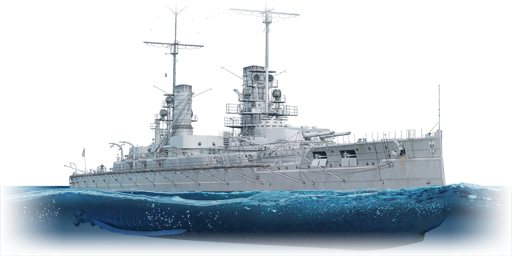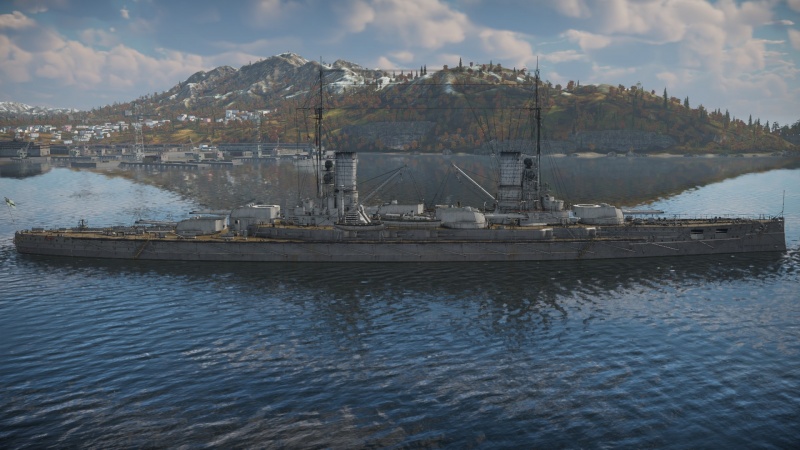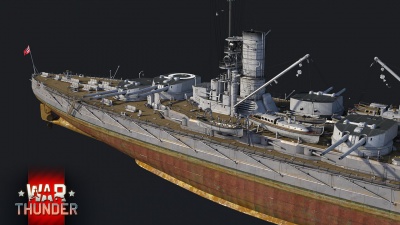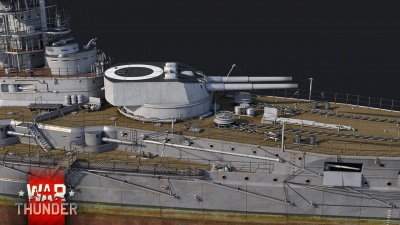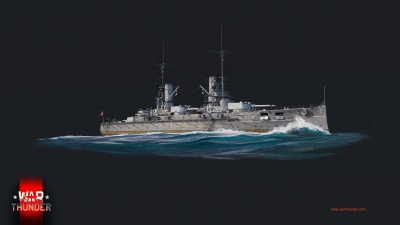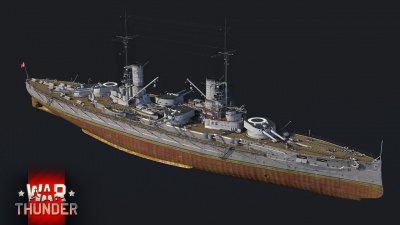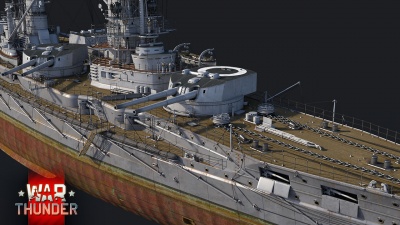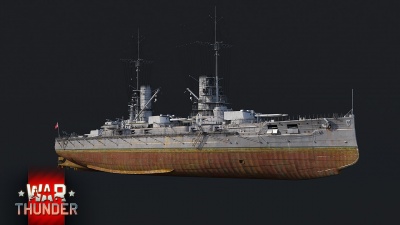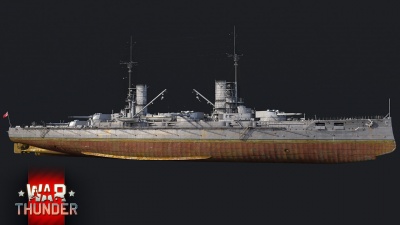Difference between revisions of "SMS Kaiser"
LethalSpork (talk | contribs) (→Survivability and armour) (Tag: Visual edit) |
Inceptor57 (talk | contribs) |
||
| Line 17: | Line 17: | ||
=== Mobility === | === Mobility === | ||
| + | {{Specs-Fleet-Mobility}} | ||
| + | <!-- ''Write about the ship's mobility. Evaluate its power and manoeuvrability, rudder rerouting speed, stopping speed at full tilt, with its maximum forward and reverse speed.'' --> | ||
The speed of Kaiser is definitely handy. While other battleships putter along at ~35km/h, Kaiser can manage 43km/h, making her faster than most other battleships. At 27400 tons, she's certainly a large ship, and her turning radius definitely reflects that. While not impossible to dodge incoming torpedoes, captains will need ample time to maneuver out of their way. | The speed of Kaiser is definitely handy. While other battleships putter along at ~35km/h, Kaiser can manage 43km/h, making her faster than most other battleships. At 27400 tons, she's certainly a large ship, and her turning radius definitely reflects that. While not impossible to dodge incoming torpedoes, captains will need ample time to maneuver out of their way. | ||
| + | |||
| + | {{NavalMobility}} | ||
| + | |||
=== Modifications and economy === | === Modifications and economy === | ||
{{Specs-Economy}} | {{Specs-Economy}} | ||
| Line 24: | Line 29: | ||
{{Specs-Fleet-Armaments}} | {{Specs-Fleet-Armaments}} | ||
=== Primary armament === | === Primary armament === | ||
| + | {{Specs-Fleet-Primary}} | ||
| + | <!-- ''Provide information about the characteristics of the primary armament. Evaluate their efficacy in battle based on their reload speed, ballistics and the capacity of their shells. Add a link to the main article about the weapon: <code><nowiki>{{main|Weapon name (calibre)}}</nowiki></code>. Broadly describe the ammunition available for the primary armament, and provide recommendations on how to use it and which ammunition to choose.'' --> | ||
| + | {{main|305 mm/50 SK L/50 (305 mm)}} | ||
The primary armament of SMS Kaiser are 10 x 305mm SK L/50 cannons. They are placed in 5 twin gunned turrets, with two super firing aft, two wing amidships and one front turret. This layout, while slightly better than its other German counterparts, still forces captains to show much of their hull when attempting to use all 10. However, 8 can still be used fairly well, as Kaiser can be sufficiently angled while still bringing front, one wing and both aft turrets to bear. This will be the go-to for many instances, as showing full broadside to enemy battleships is always asking for trouble. | The primary armament of SMS Kaiser are 10 x 305mm SK L/50 cannons. They are placed in 5 twin gunned turrets, with two super firing aft, two wing amidships and one front turret. This layout, while slightly better than its other German counterparts, still forces captains to show much of their hull when attempting to use all 10. However, 8 can still be used fairly well, as Kaiser can be sufficiently angled while still bringing front, one wing and both aft turrets to bear. This will be the go-to for many instances, as showing full broadside to enemy battleships is always asking for trouble. | ||
Simply put, these are mediocre guns when looking at other 305mm cannons from other nations. While the rounds are fired with decent muzzle velocity, their damage potential is certainly underwhelming. Kaiser can choose from three different ammo types, though only two of which have much use and dividing between the 850 total shells in the magazines, players will have to choose between a few combinations of loadouts. | Simply put, these are mediocre guns when looking at other 305mm cannons from other nations. While the rounds are fired with decent muzzle velocity, their damage potential is certainly underwhelming. Kaiser can choose from three different ammo types, though only two of which have much use and dividing between the 850 total shells in the magazines, players will have to choose between a few combinations of loadouts. | ||
| − | + | * '''HE with Base Fuse''': This is the stock ammo type for all German 305mm cannons. It is akin to a SAP round however, it lacks penetration having only 167mm at 1km. This shell type has 27kg of explosive filler, sadly the most filler of any German shell in the game. This will be fairly effective against cruisers, as the low penetration potential means it is less likely these rounds will pass through the target ship. However, they have a low amount of filler and with no potent penetration, they become ineffective against other battleships. While not impossible to ammo rack enemy battleships, it is extremely rare. Overall, this shell type is good to bring along for lighter targets and in a few cases, can be used to whittle down crew numbers and start fires on battleships. | |
| − | + | * '''Armor Piercing:''' This APC (armour-piercing capped) shell is a solid alternative to the aforementioned HE shell. With a maximum penetration of 519mm at 1km, it is an effective round against other battleships. It also has a relatively high muzzle velocity at 855m/s, making it easier to aim. Its explosive filler is quite high compared to other AP shells. In fact, it has 13.6kg of TNT, which by 305mm AP standards is very good. This shell can be used effectively against battleships, though can still punch holes in lighter targets. | |
| − | ''' | + | * '''Semi Armour Piercing:''' The SAP round of the Kaiser is really where things feel lackluster. Like with many German shells, it lacks ample amounts of filler, with only 10.8kg of TNT. This is a whopping 44.4kg less than the SAP of the Russian 305mm shells. While this shell type has a tiny bit more angle penetration, its high base penetration and its lack of filler makes it less useful against both battleships and cruisers. These shells are totally opposite to the SAP of nations like Japan and Russia, where captains can almost exclusively use SAP as their main rounds. |
| − | |||
| − | ''' | ||
| − | |||
| − | |||
| − | |||
| − | |||
=== Secondary armament === | === Secondary armament === | ||
| Line 45: | Line 47: | ||
The secondary armament is where Kaiser shines. It has 7 x 150mm and 6 x 88mm guns per side. This makes it exceptionally effective against lighter targets like destroyers, patrol boats and even some light cruisers. These guns are able to deal a devastating blow to all but the heaviest of ships in the game. However, note that the 88mm guns are labeled as AA guns when selecting between armament types, though their limited elevation and lack of a timed explosive makes them far more effective against lighter ships. Kaiser can carry a total of 2100 secondary shells. The 150mm guns however have 3 shell types once again. | The secondary armament is where Kaiser shines. It has 7 x 150mm and 6 x 88mm guns per side. This makes it exceptionally effective against lighter targets like destroyers, patrol boats and even some light cruisers. These guns are able to deal a devastating blow to all but the heaviest of ships in the game. However, note that the 88mm guns are labeled as AA guns when selecting between armament types, though their limited elevation and lack of a timed explosive makes them far more effective against lighter ships. Kaiser can carry a total of 2100 secondary shells. The 150mm guns however have 3 shell types once again. | ||
| − | + | *'''HE''': These are the stock round for secondary armaments and are exceptionally deadly to light targets like patrol boats and destroyers. They have 1.6kg of explosive, making them a good option for setting fires on larger ships as well. | |
| − | + | *'''AP''': The AP rounds from the 150mm guns will be very useful when fighting light and heavy cruisers. With 225mm of base penetration and 990g of filler, they are very good at punching through even the thickest armor belts of cruisers, even damaging turrets and barbettes. | |
| − | + | *'''SAP''': Again, the SAP from German guns tends to be underwhelming. These round have 15g more explosive filler than the AP while sacrificing 131mm of base penetration. They still may be used effectively against lighter targets, but a combination of AP and HE shells will do better at fighting all types of targets. | |
| − | |||
| − | |||
=== Anti-aircraft armament === | === Anti-aircraft armament === | ||
| Line 67: | Line 67: | ||
== Usage in battles == | == Usage in battles == | ||
<!-- ''Describe the technique of using this ship, the characteristics of her use in a team and tips on strategy. Abstain from writing an entire guide – don't try to provide a single point of view, but give the reader food for thought. Talk about the most dangerous opponents for this vehicle and provide recommendations on fighting them. If necessary, note the specifics of playing with this vehicle in various modes (AB, RB, SB).'' --> | <!-- ''Describe the technique of using this ship, the characteristics of her use in a team and tips on strategy. Abstain from writing an entire guide – don't try to provide a single point of view, but give the reader food for thought. Talk about the most dangerous opponents for this vehicle and provide recommendations on fighting them. If necessary, note the specifics of playing with this vehicle in various modes (AB, RB, SB).'' --> | ||
| − | Kaiser is definitely a fun ship to play given the right circumstance. While she doesn't stack up to ships like Marlborough or Mariya, | + | Kaiser is definitely a fun ship to play given the right circumstance. While she doesn't stack up to ships like Marlborough or Mariya, she does still have the armour to take quite a few hits. The main armament of Kaiser is best used at longer range, as plunging fire only helps its lower penetration rounds find weak spots. Surprisingly though, she can be extremely effective in close quarters as well, using her strong belt and bow plating to tank rounds from cruisers and even battleships. However, the armour below the forward barbette is a weaker than other battleships and can be exploited by other large caliber rounds from opposing dreadnoughts. The speed of Kaiser is very useful up close and its slightly better turning radius compared to other ships allows better responsiveness to incoming torpedoes, though captains will still need to stay vigilant. |
Additionally, the overwhelming firepower of the secondary battery makes Kaiser a very formidable opponent up close, especially against light targets. However, its lack of air defense makes it an easy target for high flying and dive bombing planes, so be careful. | Additionally, the overwhelming firepower of the secondary battery makes Kaiser a very formidable opponent up close, especially against light targets. However, its lack of air defense makes it an easy target for high flying and dive bombing planes, so be careful. | ||
| Line 75: | Line 75: | ||
=== Pros and cons === | === Pros and cons === | ||
<!-- ''Summarise and briefly evaluate the vehicle in terms of its characteristics and combat effectiveness. Mark its pros and cons in the bulleted list. Try not to use more than 6 points for each of the characteristics. Avoid using categorical definitions such as "bad", "good" and the like - use substitutions with softer forms such as "inadequate" and "effective".'' --> | <!-- ''Summarise and briefly evaluate the vehicle in terms of its characteristics and combat effectiveness. Mark its pros and cons in the bulleted list. Try not to use more than 6 points for each of the characteristics. Avoid using categorical definitions such as "bad", "good" and the like - use substitutions with softer forms such as "inadequate" and "effective".'' --> | ||
| − | |||
'''Pros:''' | '''Pros:''' | ||
| − | + | * Fast with decent agility | |
| − | + | * Fantastic secondary battery | |
| − | + | * Great belt armour for up close battles | |
| − | |||
| − | |||
| − | |||
| − | |||
| − | |||
'''Cons:''' | '''Cons:''' | ||
| − | + | * Lackluster main battery shells | |
| − | + | * Little air defense | |
| − | + | * Weaker internal armour | |
| − | |||
| − | |||
| − | |||
| − | |||
== History == | == History == | ||
Revision as of 02:13, 3 April 2022
Contents
Description
The Kaiser-class, SMS Kaiser, 1911 is a rank V German battleship with a battle rating of 6.3 (AB/RB/SB). It was introduced in Update "Ixwa Strike".
General info
Survivability and armour
SMS Kaiser was the lead ship of the Kaiser Class of dreadnought battleships. Laid down in 1909, she was launched in 1911 and commissioned in 1912. It saw action at the famous Battle of Jutland and served until the end of the war, being interned at Scapa Flow following the armistice.
The Kaiser is undoubtedly a formidable ship. She has plenty of armour, up to 350mm on the main belt. However, the frontal armor, just below the forward barbette is a major weak spot, having only 170mm behind an additional sloped 60mm. She is also relatively fast compared with other battleships, being able to cruise at a whopping 23 knots or 43km/h (in RB). Her armament scheme, with two wing turrets amidships, also allows for a full 10 gun broadside, making it more effective than the Helgoland and Westfalen with only 8. However, her lower compliment of crew, 1084, leaves her slightly more vulnerable to fires and sustained gunfire.
Mobility
The speed of Kaiser is definitely handy. While other battleships putter along at ~35km/h, Kaiser can manage 43km/h, making her faster than most other battleships. At 27400 tons, she's certainly a large ship, and her turning radius definitely reflects that. While not impossible to dodge incoming torpedoes, captains will need ample time to maneuver out of their way.
| Mobility Characteristics | |||
|---|---|---|---|
| Game Mode | Upgrade Status | Maximum Speed (km/h) | |
| Forward | Reverse | ||
| AB | |||
| Upgraded | 51 | 25 | |
| RB/SB | |||
| Upgraded | 43 | 22 | |
Modifications and economy
Armament
Primary armament
The primary armament of SMS Kaiser are 10 x 305mm SK L/50 cannons. They are placed in 5 twin gunned turrets, with two super firing aft, two wing amidships and one front turret. This layout, while slightly better than its other German counterparts, still forces captains to show much of their hull when attempting to use all 10. However, 8 can still be used fairly well, as Kaiser can be sufficiently angled while still bringing front, one wing and both aft turrets to bear. This will be the go-to for many instances, as showing full broadside to enemy battleships is always asking for trouble.
Simply put, these are mediocre guns when looking at other 305mm cannons from other nations. While the rounds are fired with decent muzzle velocity, their damage potential is certainly underwhelming. Kaiser can choose from three different ammo types, though only two of which have much use and dividing between the 850 total shells in the magazines, players will have to choose between a few combinations of loadouts.
- HE with Base Fuse: This is the stock ammo type for all German 305mm cannons. It is akin to a SAP round however, it lacks penetration having only 167mm at 1km. This shell type has 27kg of explosive filler, sadly the most filler of any German shell in the game. This will be fairly effective against cruisers, as the low penetration potential means it is less likely these rounds will pass through the target ship. However, they have a low amount of filler and with no potent penetration, they become ineffective against other battleships. While not impossible to ammo rack enemy battleships, it is extremely rare. Overall, this shell type is good to bring along for lighter targets and in a few cases, can be used to whittle down crew numbers and start fires on battleships.
- Armor Piercing: This APC (armour-piercing capped) shell is a solid alternative to the aforementioned HE shell. With a maximum penetration of 519mm at 1km, it is an effective round against other battleships. It also has a relatively high muzzle velocity at 855m/s, making it easier to aim. Its explosive filler is quite high compared to other AP shells. In fact, it has 13.6kg of TNT, which by 305mm AP standards is very good. This shell can be used effectively against battleships, though can still punch holes in lighter targets.
- Semi Armour Piercing: The SAP round of the Kaiser is really where things feel lackluster. Like with many German shells, it lacks ample amounts of filler, with only 10.8kg of TNT. This is a whopping 44.4kg less than the SAP of the Russian 305mm shells. While this shell type has a tiny bit more angle penetration, its high base penetration and its lack of filler makes it less useful against both battleships and cruisers. These shells are totally opposite to the SAP of nations like Japan and Russia, where captains can almost exclusively use SAP as their main rounds.
Secondary armament
The secondary armament is where Kaiser shines. It has 7 x 150mm and 6 x 88mm guns per side. This makes it exceptionally effective against lighter targets like destroyers, patrol boats and even some light cruisers. These guns are able to deal a devastating blow to all but the heaviest of ships in the game. However, note that the 88mm guns are labeled as AA guns when selecting between armament types, though their limited elevation and lack of a timed explosive makes them far more effective against lighter ships. Kaiser can carry a total of 2100 secondary shells. The 150mm guns however have 3 shell types once again.
- HE: These are the stock round for secondary armaments and are exceptionally deadly to light targets like patrol boats and destroyers. They have 1.6kg of explosive, making them a good option for setting fires on larger ships as well.
- AP: The AP rounds from the 150mm guns will be very useful when fighting light and heavy cruisers. With 225mm of base penetration and 990g of filler, they are very good at punching through even the thickest armor belts of cruisers, even damaging turrets and barbettes.
- SAP: Again, the SAP from German guns tends to be underwhelming. These round have 15g more explosive filler than the AP while sacrificing 131mm of base penetration. They still may be used effectively against lighter targets, but a combination of AP and HE shells will do better at fighting all types of targets.
Anti-aircraft armament
The Anti-Air aspect of Kaiser is lacking however this is typical for most battleships currently in game. It has 12 x 88mm guns, half of which in hull mounted casemates. Therefore, the elevation of said guns (only +18°), is not overly useful. There are of course 6 guns mounted in superstructures, however they too lack meaningful elevation and traverse speed. This results in a large zone above the ship where captains will be completely vulnerable to attack. While the 88mm guns can be used to shoot at low flying targets, their lack of elevation and traverse speed makes them hard to use in the AA role. As before, they are much easier to use as light ship deterrents.
Additional armament
Kaiser is armed with multiple 500mm torpedoes. They have a relatively small warhead of only 160kg and have a mild range of 5km. They also move at a whole 50km/h, meaning cruisers and destroyers can simply outrun them, let alone dodge them. However, in rare circumstances, they can still be effective as a surprise attack on an enemy vessel. Loading them will make Kaiser easier to ammo rack as well.
Usage in battles
Kaiser is definitely a fun ship to play given the right circumstance. While she doesn't stack up to ships like Marlborough or Mariya, she does still have the armour to take quite a few hits. The main armament of Kaiser is best used at longer range, as plunging fire only helps its lower penetration rounds find weak spots. Surprisingly though, she can be extremely effective in close quarters as well, using her strong belt and bow plating to tank rounds from cruisers and even battleships. However, the armour below the forward barbette is a weaker than other battleships and can be exploited by other large caliber rounds from opposing dreadnoughts. The speed of Kaiser is very useful up close and its slightly better turning radius compared to other ships allows better responsiveness to incoming torpedoes, though captains will still need to stay vigilant.
Additionally, the overwhelming firepower of the secondary battery makes Kaiser a very formidable opponent up close, especially against light targets. However, its lack of air defense makes it an easy target for high flying and dive bombing planes, so be careful.
Overall, Kaiser is a well rounded ship, being able to sit comfortable at range and duel with its main guns, or take it up close and brawl with unsuspecting cruisers. While its main guns lack filler, it can still be effective against all types of enemies and will surely be fun to take out once in a while.
Pros and cons
Pros:
- Fast with decent agility
- Fantastic secondary battery
- Great belt armour for up close battles
Cons:
- Lackluster main battery shells
- Little air defense
- Weaker internal armour
History
Devblog
During the 1900’s, the German Imperial navy placed orders for five new dreadnought battleships to be constructed in order to replace older warships of the Siegfried and Odin classes. These five new ships would become the Kaiser-class battleships, which among other technological advancements, featured turbine propulsion systems - a novelty on German warships at the time.
Kaiser, the lead ship of the class, was laid down in Kiel in December 1909, launched in March 1911 and subsequently commissioned in August 1912. After crew training and taking part in several fleet exercises, Kaiser along with its sistership König Albert and cruiser Strassburg, was sent on a long-distance cruise to German South-West Africa and South America to test the novel steam propulsion system for endurance and reliability. The flotilla returned from their cruise to Kiel in June of 1914.
Following the outbreak of the Great War, Kaiser took part in nearly every major naval operation of the conflict. This included the famous Battle of Jutland in mid 1916, where Kaiser sustained two direct hits, but suffered no substantial damage. Furthermore, Kaiser also took part in Operation Albion in 1917, bombarding Russian coastal positions in the Baltic, and crippling the destroyer Grom, followed by her sinking.
With the German surrender in November 1918, part of the High Seas Fleet, including the SMS Kaiser, was interned at the British naval base at Scapa Flow. The commanding German officer, Rear Admiral Ludwig von Reuter, believing that the fleet would be seized by the British, ordered the scuttling of the entire fleet on 21st of June, 1919. Kaiser was later raised in 1929 and broken up for scrap in the early 1930’s.
Media
- Skins
- Images
See also
Links to articles on the War Thunder Wiki that you think will be useful for the reader, for example:
- reference to the series of the ship;
- links to approximate analogues of other nations and research trees.
External links
| Deutsche Werke AG | |
|---|---|
| Light Cruisers | |
| K-class | Karlsruhe |
| Leipzig-class | Nürnberg |
| Battleships | |
| Kaiser-class | SMS Kaiser* |
| *Previously Kaiserliche Werft Kiel | |
| Germany battleships | |
|---|---|
| Nassau-class | SMS Nassau · SMS Westfalen |
| Helgoland-class | SMS Helgoland · SMS Ostfriesland |
| Kaiser-class | SMS Kaiser |
| Bayern-class | SMS Bayern · SMS Baden · SMS Sachsen |


